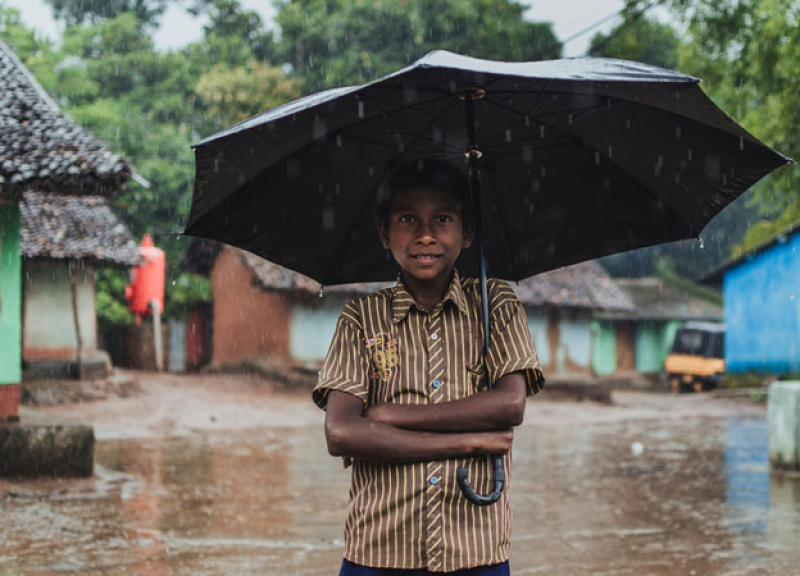- Tarique Vows to Return, be With People During Polls |
- Exports Dip 4.5pc in September Amid US Tariff Impact |
- Hamas calls for swift hostage-prisoner swap as talks set to begin |
- Leadership vacuum cripples primary education in Sonargaon |
- Tornado destroys over 500 houses in Nilphamari, injures 30 |
Odisha’s ‘Zero Casualty’ Model Sets Global Resilience Example

A young boy was standing in front of a flooded area in Thuamul Rampur, Odisha, India. Disaster shelters are vital to ensure the normal livelihood in disaster-prone areas.
South Asia, home to nearly two billion people, ranks among the most disaster-prone subregions in Asia and the Pacific. Every year, millions face floods, cyclones, and other extreme weather events. The Bay of Bengal alone accounts for nearly 80 per cent of global cyclone-related deaths, with storms striking Bangladesh, India, and Sri Lanka with increasing frequency.
Although South Asia hosts one-quarter of the world’s population, it also contains nearly half of the global population living in poverty — a factor that amplifies vulnerability across the subregion. Building disaster resilience is therefore not only urgent but existential.
Odisha, with its long coastline, has repeatedly faced severe cyclones that have claimed lives and destroyed property. The devastation caused by the 1999 super cyclone — which exposed the lack of coordinated warning systems, resilient shelters, and effective relief mechanisms — became a turning point for the state.
When Cyclone Phailin struck in 2013, Odisha evacuated more than one million people, saving thousands of lives compared to 1999. In 2019, Cyclone Fani brought extensive destruction, but fatalities remained below 100. These outcomes illustrate Odisha’s transformation from one of India’s most disaster-affected states into a pioneer of anticipatory disaster governance.
This success did not happen by chance. Odisha adopted a “zero casualty” model, established the Odisha State Disaster Management Authority (OSDMA) in 2000, and invested in cyclone shelters, early warning systems, and a specialised disaster response force. Most importantly, it placed communities and local governance at the centre of its approach.
The state redefined preparedness by integrating local governments into disaster planning, building resilient infrastructure, and mobilising social capacity through women’s groups, village committees, and trained volunteers. This people-centred model turned disaster management from a top-down directive into a community-driven movement.
Comparative Cyclone Outcomes in Odisha
Building Disaster Resilience and Beyond
Odisha’s experience is more than a local success story — it offers a global lesson. As climate change intensifies storms, floods, and heatwaves across Asia and beyond, countries from Bangladesh to the Philippines face similar risks. Odisha demonstrates that resilience depends not only on high-tech forecasting systems but also on empowered local institutions, trust, and participation.
Learning from Odisha highlights two key aspects of disaster risk management:
Local leadership and community group support: Local leaders, familiar with terrain and vulnerable groups, act as effective first responders during emergencies. Community groups extend this reach by mobilising people, building trust, and ensuring that warnings translate into collective action.
Resilient infrastructure with rapid response and technology support: A combination of robust infrastructure, specialised rapid response forces, and technology-driven early warning systems ensures faster evacuations, safer shelters, and timely relief during major cyclones.
The Way Forward: From Local Action to Global Responsibility
Odisha’s story shows that resilience is strongest when every actor plays a role. National governments, local authorities, communities, international organisations, and the private sector each contribute in distinct ways — together turning effective practices into global standards.
Governments build the backbone of resilience by establishing strong policies, legal frameworks, and sustained investments in disaster infrastructure. They must lead by setting “zero casualty” goals, funding cyclone shelters, expanding early warning systems, and empowering local institutions. Local governments, in turn, serve as frontline implementers, ensuring that policies translate into action.
Local communities provide the foundation of preparedness. Villages, self-help groups, and local councils transform official warnings into coordinated action by mapping evacuation routes, training volunteers, and fostering trust so that alerts prompt immediate response.
International organisations connect local success to global progress. By financing early warning systems, facilitating South–South knowledge exchange, and scaling up community-based models, organisations such as ESCAP and UNDRR can amplify the impact across borders.
The private sector drives innovation and investment. Telecom operators, fintech companies, and renewable energy providers can enhance disaster communication, enable mobile payments for relief, and power shelters sustainably. Insurance companies can design affordable products that help households and businesses recover more quickly.
Odisha’s experience illustrates how deliberate reforms, paired with strong community participation, can save thousands of lives. As climate change intensifies hazards across Asia and the Pacific, Odisha’s model demonstrates that resilience relies not only on technology and infrastructure but also on trust, participation, and local capacity.
Rajan Sudesh Ratna is Deputy Head, ESCAP Subregional Office for South and South-West Asia; Jing Huang is Economic Affairs Officer, ESCAP Subregional Office for South and South-West Asia; and Sanjit Beriwal is Research Intern, ESCAP Subregional Office for South and South-West Asia.

